Another week’s postings from August:
11th August 2017
Another view of the swing bridge across the entrance lock to the former fish dock. St Andrew’s Dock had been built with the coal trade in mind, but was opened in 1883 as the fish dock, and remained in that use until 1975, when the fishing fleet moved to nearby Albert Dock.
The area around the lock was designated as a conservation area in 1990, but the Lord Line building – trawler owners offices built in 1949 – is only locally listed. In May 2017 Hull Council issued an enforcement order against the building’s owners telling them to make it safe and secure after many photographs taken inside the building and on its roof had been published. The owners response was to put in plans to demolish both this building and the nearby listed Hydraulic Tower and Pump House, which environment officers have rejected.
Although people in Hull welcomed the recent listing of around ten Hull buildings in recognition of its year as UK City of Culture, many were disappointed that Lord Line and the also the threatened huge ‘Three Ships’ mosaic on the former BHS store were not also protected.
Most of the other buildings visible in the picture have now gone. In the distance at the left of the picture you can see the distinctive chimneys of two of the fish smoke houses.
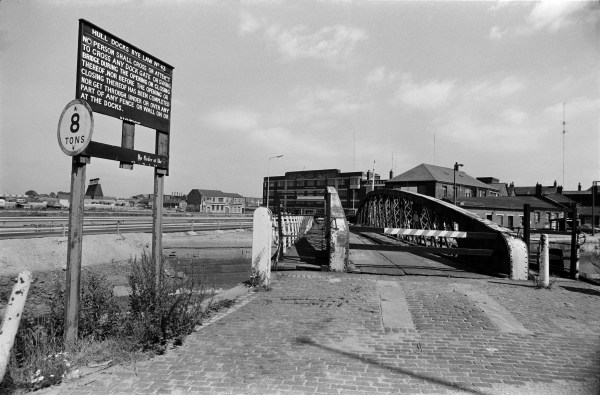
36k54: Swing Bridge, St Andrews Dock entrance and Lord Line building, 1983 – Docks
12th August 2017
Water still remained in St Andrew’s Dock, though the entrance was now closed by the roadway across it. The main part of the Lord Line Building was I think empty, though people still seemed to be working in some of the other buildings around where cars and a van and a lorry are parked.
The Lord Line building was still in good condition, with not a single broken window. On its frontage are the names of some of the companies which used it – British United Trawlers Limited, Marconi Marine, J Marr & Son and another I can’t quite read.
At the end of the road are trawlers in William Wright Dock. Of the buildings on the right only the listed hydraulic tower remains. The Lord Line building has been deliberately left open to vandalism for years but its basic shell appears sound.
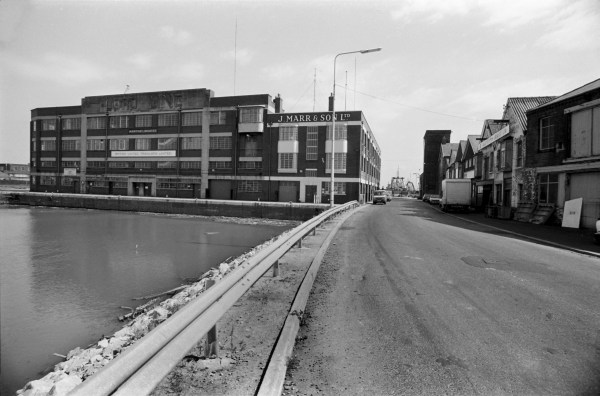
36k55: St Andrew’s Dock, Lord Line Building and road, 1983 – Docks
13th August 2017
St Andrew’s Dock had been the fish dock since it opened in 1883 until it was abandoned in 1975, with what remained of the fishing industry moving a short distance east to Albert Dock.
Those that remained of the businesses around the dock moved with it, leaving empty buildings, some dating from the 1880s, and they quickly deteriorated.
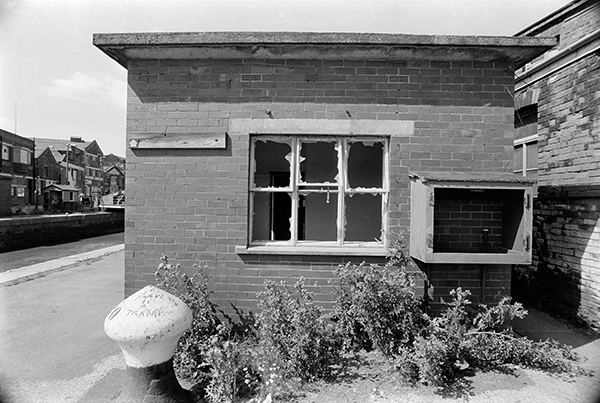
36k61: Abandoned buildings, St Andrew’s Dock, 1983 – Docks
14th August 2017
CEA Towne Ship Riggers Ltd is a family firm founded in 1948, becoming a private limited company in 1951, and still trading as the Towne Group. The plates by the office door show it was also the registered office for Charles Towne Agencies Ltd and ‘Ropes & Rigging Ltd’ presumably all part of the group. The bottom plate is for the Fleetwood Trawler Supply Company Ltd which was set up in 1912 to supply Fleetwood trawlers with oil burning navigation lamps and also provided sheet metal work, ships rigging, sail making, chandlery and provisions, and which became a part of the Towne Group, which also includes a farm on Hull Road in Skirlaugh.
The business of the companies has changed somewhat with the end of the fishing industry; some of the companies are now longer active but the Towne Group is now particularly involved with lifting equipment.
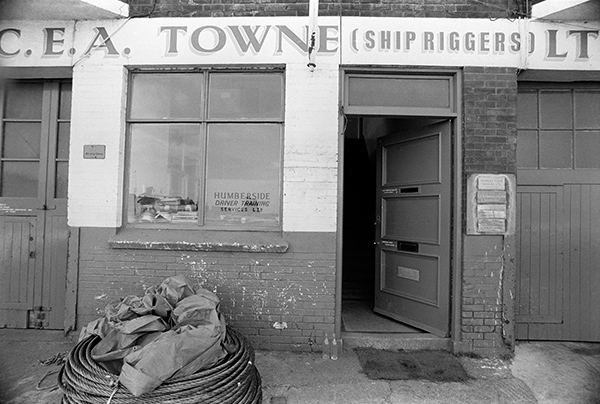
36k65: CEA Towne (Ship Riggers) Ltd, St Andrew’s Dock, 1983 – Docks
15th August 2017
Empty cable drums and coils of rope on the dockside at St Andrew’s Dock. The reflection in the window shows a fish smoke house and what I think is a part of the trawler owner’s offices in the Lord Line building.
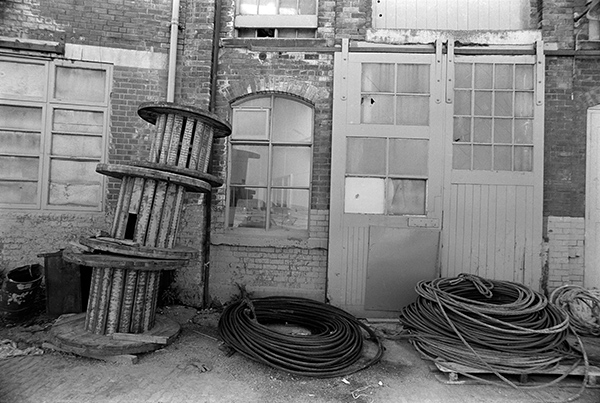
36k66: Abandoned workshops, St Andrew’s Dock, 1983 – Docks
16th August 2017
I was fascinated by the texture and marks on this wall and the tall, slim post embedded in the concrete path in front of it on a corner of Lime St, to the east of the River Hull, and photographed it on several occasions. There was something about the vertical stains coming down the wall with their diffuse edges and the precise edge of the post, as well as the square aperture in the wall, and there always seemed a peculiar quality of light here, with the tall and fairly light coloured wall acting as a huge reflector.
There was a certain mystery about it. Lime St now has no walls, no posts like this.
Lime St is said to have got its name from the time when the processing of whales was one of Hull’s main industries. There were pits of quicklime beside the river where the whales were rendered down. It was an industry that gained the street the reputation of being the smelliest street in England. It was still a street lined on both sides by industrial premises – including the wharves along the River Hull on its west side – when I took this picture in 1983.
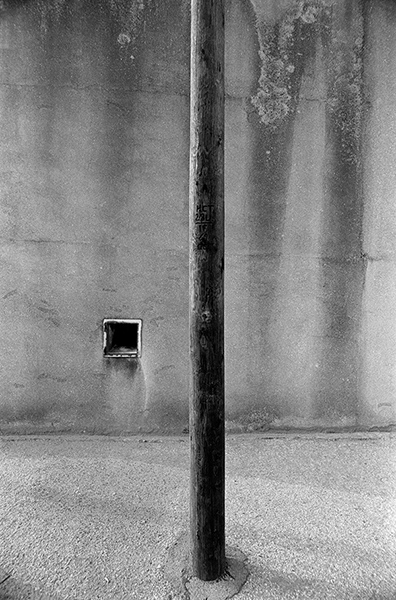
36l24: Post and Wall, Lime St, 1983 – River Hull
17th August 2017
The first of a few pictures from Goole, which I visited briefly. The port of Goole was always linked with that of Hull, as well as being a competitor, with barges taking goods between the two. Goole has its canal connections with West Yorkshire and beyond while Hull was closer to the sea and has docks for large ocean-going vessels.
The silo now helpfully has the name Hudson Ward across the top and is the Hudson Ward mill; it was perhaps being repainted when I took this picture in August 1983. The company are flour millers and manufacturers of animal foods of all kinds and came to Goole in 1885. On 31st December 1893 the partnership between Thomas Francis Hudson, Robert Robinson, and Thomas Hanley was officially dissolved and the business carried as the Hudson, Ward and Company Limited, Flour and Corn Merchants and Millers at the Dock Mills, Goole.
Robert Robinson was a farmers son, born in 1846 at Thorne Levels and worked on his father’s farm until he bought a flour mill at Conisborough in 1870 with his father-in-law T F Hudson. Four years later he rented a mill at Doncaster with Thomas Hanley, which unfortunately burnt down in 1881. They bought a mill at Retford and rebuilt the Doncaster mill.
The mill at Goole was opened around 1885 and cost around £18,000 though possibly older existing buildings on the site were used as offices. The rather plain silo in my pictures I think probably dates from the 1930s, built alongside the original six storey brick building which had many more windows and electric lighting and was demolished probably in the 1970s. Hudson Ward were formed when Robinson retired, spending a few years travelling abroad and later becoming a well-known Doncaster councillor and Mayor from 1902-3. He was also a leading Methodist in the area, as were several of Hull’s leading industrialists.
The major part of the wheat used for flour milling is brought up the river in the firm’s fleet of barges direct from trans-Atlantic ships in Hull and discharged in bulk into this large 4,000-ton silo on the north side of Goole’s South Dock.
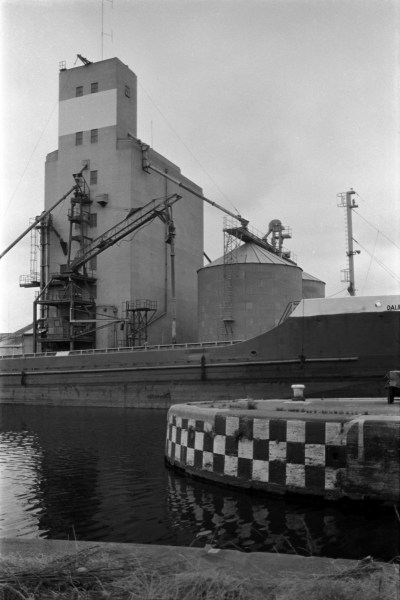
36l32: Daunt Rock berthed at silo, South Dock from Bridge St, Goole, 1983 – Goole
You can see the new pictures added each day at Hull Photos, and I post them with the short comments above on Facebook.
Comments and corrections to captions are welcome here or on Facebook.
______________________________________________________
There are no adverts on this site and it receives no sponsorship, and I like to keep it that way. But it does take a considerable amount of my time and thought, and if you enjoy reading it, a small donation – perhaps the cost of a beer – would be appreciated.
My London Diary : Buildings of London : River Lea/Lee Valley : London’s Industrial Heritage
All photographs on this and my other sites, unless otherwise stated, are taken by and copyright of Peter Marshall, and are available for reproduction or can be bought as prints.